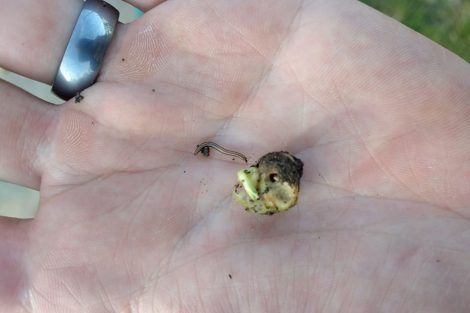Printable PDF
In This Issue
- Pea Weevil Damage
- Asparagus Beetle Damage
- Millipede Damage
Pea Weevil Damage
Monitoring
Adults overwinter under vegetable debris and alfalfa/clover fields. Eggs are laid in late April through early May. Scout for weevils during cool and wet conditions. Check emerging pea plants and underneath dirt clods where adults may be hiding. Pea weevils are slender, 5 mm long, grey-brown in color, and have a notable snout. Larvae are c-shaped, 5 mm long, and are white with a brown head.
Damage
Adults chew prominent half-circle notches out of the leaf margins while the larvae feed on root nodules.
Management
Consider treatment when there is a 25% growing-point injury on seedlings. Implement crop rotation by moving peas away from other legumes. Irrigation and proper fertilization may help crops outgrow the damage. Home pesticide options include: Garden Tech Sevin.
Asparagus Beetle Damage
Monitoring
Adults and eggs are first seen in mid-May through July. Scout for adults in the afternoon feeding on asparagus spears. Adults are 5-6 mm long, brightly colored with four yellow spots, orange wing margins, and a bluish-black head. Spotted asparagus beetles are mostly orange with six black spots on their fore wings. Monitor for dark eggs “glued” to spears.
Damage
Most serious damage occurs in early spring when new spears are breaking through the soil. Adults and larvae feed with chewing mouthparts consuming leaves and chewing pits into the spears. Larvae chew on ferns, giving them a bleached appearance and reducing photosynthesis.
Management
Consider treatment when persistent beetle damage occurs. Remove volunteer asparagus and reduce weeds near the growing site. Encourage predatory beetles and parasitic wasps. Home pesticide options include; Garden Tech Sevin and Safer Brand Insecticidal Soap & Pyrethrin Concentrate.
Millipede Damage
Monitoring
Millipedes are arthropods, typically they’re long, slender, hard-shelled, and range from red to black. Millipedes overwinter as adults and immature stages in sheltered areas under debris, boards, or equipment. In the spring, adults lay their eggs.
Damage
In Utah, there have been reports of millipedes causing damage to small roots and germinating seedlings of beans, corn, and peas.
Management
Control is not recommended in garden settings, as threats are rarely serious. Focus on prevention through yard sanitation. Remove decaying vegetation, dead leaves, grass, and other debris to help reduce their numbers. If the damage is occurring, remove excess mulch from the area to take away their shelter.









